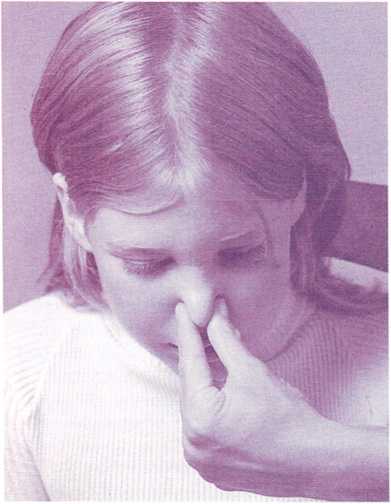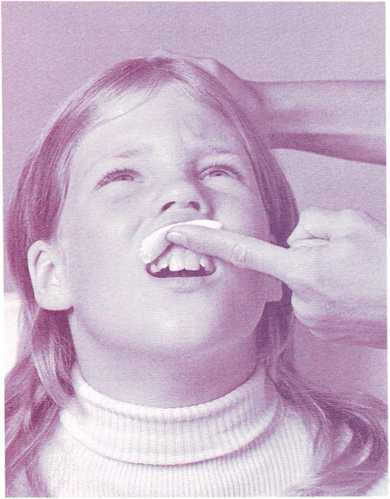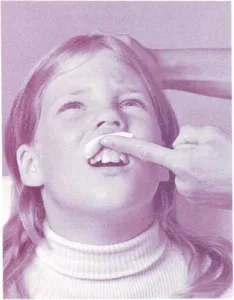Nose, Objects in the – Nosebleed
Nose, objects in the. Sometimes by accident, and sometimes just to
find out what will happen, a child puts an object into a nostril. If the
child’s nose bleeds, or if you cannot see the foreign object, call your
doctor immediately.
Occasionally, the child may get the object out quite easily by sneezing
it out, or may force it out by blowing the nose. Ask a child to blow the
nose only if you know the child will not sniff in instead of blowing
out.
You may be able to remove a soft object from your child’s nose by using
a pair of tweezers. Do this only if you can see the object. And be
careful not to injure the child’s nostril. Warn the child not to move
while you are trying to remove the foreign object.
Never try to remove a smooth, hard object from a child’s nose. The
object may be pushed farther into the nose quite easily and might get
into the throat and choke the child. Call your doctor immediately, and
let the doctor remove the object, [c.f.f.]
Nose drops help clear up a stuffy nose, and are often recommended by
doctors. Nose drops help clear the nostrils of mucus. A prescription is
usually not necessary. You can mix 1 teaspoon of table salt in 2 cups of
water and store the solution until needed.
Using a clean dropper, place a few drops of the solution in each nostril
until bubbles appear. Then use a small bulb syringe to aspirate the
mucus from each nostril. It is helpful to administer the drops before
each feeding and before the baby goes to sleep.
In some instances, your child’s doctor may order prescription drops. Use
the drops only in the specified amount. Young children can suffer from
an overdose of the drugs in these solutions. Never continue nose drops
indefinitely.
If your baby struggles when you try to administer nose drops, lay the
baby in your lap or on a bed, whichever you feel is more

One effective way to stop a nosebleed is to pinch the nostrils shut
while the child is sitting up and leaning forward.
convenient and comfortable for you. Put one arm around or over the baby
to keep the baby still, and hold the baby’s chin with your hand. Leave
your other hand free to put in the drops.
Another common method of giving nose drops is to lay the baby on your
lap with the baby’s head between your knees. In this way, you can
confine the head with your knees, hold the baby’s hands with one of your
hands, and still have one hand free for inserting the drops,
[ct.e.]

Pressing a wad of cotton under a child’s upper lip is another common
method of stopping a nosebleed.
Nosebleed may be caused by a punch in the nose or a fall. A child’s
nose may also bleed if the child picks it, pokes something into it, or
blows it too hard. Colds, other infections, and extremely dry air may
also rupture tiny blood vessels. Fortunately, most nosebleeds in
children occur in the front, central part of the nose, where you can
easily apply pressure to stop the bleeding-
If your child has a nosebleed, have the child sit up and lean forward,
if possible. Or, place the child in a reclining position with head and
shoulders raised. Pinch the nostrils shut for at least 10 minutes as the
child breathes through the mouth. If bleeding continues, put a small pad
of cotton or gauze in the bleeding nostril and apply pressure.
When the bleeding stops, do not let your child blow the nose for a
while. This could disturb the blood clots and start another nosebleed.
If bleeding does not stop in 10 to 15 minutes, call a doctor. In severe
cases, a doctor may need to pack the nose with gauze, or cauterize the
bleeding points.

